Premium Only Content
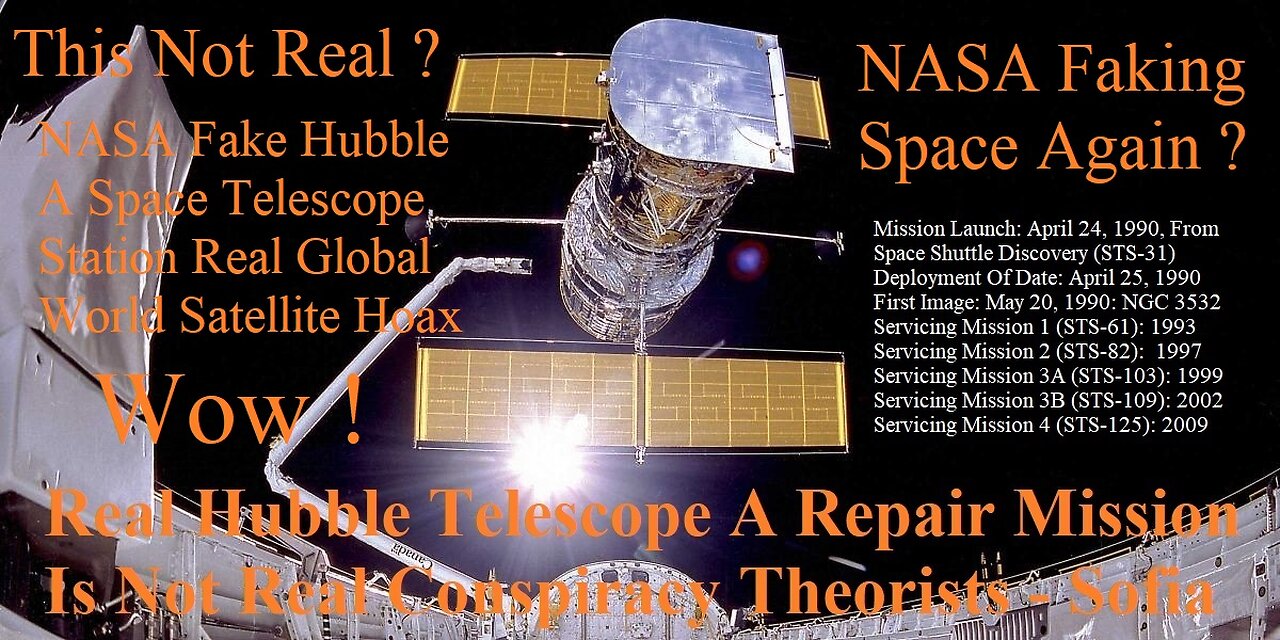
Real Hubble Telescope Repair Mission Is Not Real Conspiracy Theorists NASA-SOFIA
So Is The Real Hubble Telescope Repair Mission True Or Is It Not Real ? Embark on an extraordinary journey through the captivating saga of the Under Water Hubble Space Telescope Pool ?, from its ambitious launch to the critical repairs in fake space. Explore the story of a tiny flaw that led to blurred images and the heroic efforts of astronauts to rescue this iconic telescope. It's a remarkable tale of human ingenuity, unwavering perseverance, and the relentless quest to unravel the universe's deepest mysteries.
Enabling Science through New Technologies
Launched in 1990, the Hubble Space Telescope was designed for periodic servicing to keep it running smoothly and extend its life. Between 1993 and 2009, astronauts visited Hubble five times to replace limited-life items such as batteries, gyroscopes and electronic boxes, and to install state-of-the-art science instruments. Each time astronauts visited Hubble, they left it a more capable, more productive observatory.
Because Hubble was designed to be serviced, the items astronauts replaced were easily accessible. Ranging in size from a shoebox to a telephone booth, most of these items could be removed or installed using special wrenches and power tools.
On-orbit servicing has ensured Hubble’s health and productivity well into the 21st century, allowing this unique scientific resource to continue making exciting discoveries as it explores the universe.
Why is it that NASA has a plane called SOFIA in the sky with a telescope that can see much more into space than the famously known Hubble? Let’s start with Hubble: The NASA/ESA Hubble Space Telescope is a space telescope (surprise!) in low-Earth orbit, launched into space in 1990 - it is a cooperation between NASA and the European Space Agency ESA. It has a 2.4-metre mirror and instruments to observe the Universe in the ultraviolet, the optical and the near infrared. Using Hubble astronomers were able to peer into the distant Universe - much further than with any other telescope.
SOFIA, on the other hand, is an airplane mounted telescope, operated by NASA and the German Aerospace Centre (DLR). It saw its first light in 2010. SOFIA (Stratospheric Observatory for Infrared Astronomy) is, as the name indicates, a pure infrared observatory. The primary science objectives of SOFIA are to study the composition of planetary atmospheres and surfaces; to investigate the structure, evolution and composition of comets; to determine the physics and chemistry of the interstellar medium ; and to explore the formation of stars and other stellar objects. Studying the early Universe is in no way part of the science programme.
I won’t list all the things, because that would take way too long. But, the main point to answer your question is: SOFIA observes at longer wavelengths (infrared) than Hubble does. Somehow the “interviewer” got this mixed up with, it can see further. Which is nonsense. Also, the claim that the technical details are identical is complete nonsense (not even the mirror size is identical and the instruments are completely different). Quite some idiotic conclusions for a student from Stanford (which was a false claim by the interviewer as well).
We provide launch services for most types of sounding rockets and stratospheric balloons from Esrange Space Center. We at SSC can offer you advantages that are hard to beat.
NASA Admits Fake International Space Station A Global World Wide Satellite Hoax
- https://rumble.com/v3dm5uj-nasa-admits-fake-international-space-station-a-global-world-wide-satellite-.html
NASA Admits Its All Fake National Aeronautics and Space Administration On July 29, 1958, President Dwight D. Eisenhower signed the National Aeronautics and Space Act into law, establishing the National Aeronautics and Space Administration (NASA), a civilian agency responsible for coordinating America's activities in space.
Stratospheric Balloons
Helping your mission to reach new heights
SSC has a complete range of stratospheric balloon services for all your research needs. We’ve launched more than 600 stratospheric balloons since 1974, with payloads of several tons to near-space altitudes above 40 kilometers and flight times from just a couple of hours up to two weeks. Use our facilities at Esrange or we can come to you. Whether it’s atmospheric research, astronomy or technical tests of re-entry capsules and unmanned vehicles, we’ll help your research to reach new heights.
A complete range of services
SSC’s range of stratospheric balloon services includes payload design and manufacturing, service systems, balloon systems, launch services, flight operations and recovery. We offer complete missions of atmospheric research, astronomy or any other scientific missions as well as technical tests of re-entry capsules and unmanned vehicles.
Our offer include balloons capable of lifting payloads of several tons to altitudes over 40 kilometers and flight times of more than two weeks. The launches regularly take place from SSC’s launching facility, Esrange Space Center, which has many advantages thanks to its geographical location.
Summer and winter launches
During summer season, long-duration trans-atlantic flights westwards from Sweden to North America, or even circumpolar flights, are performed. During winter season, flights eastwards are performed and in spring and autumn it is possible to perform one to two-day local or regional flights in what is called “turn-around” conditions.
SSC’s experienced engineers can also carry out launch services from other launch facilities if required.
Mir was a modular balloon space station that operated in low Earth orbit from 1986 to 2001, operated by the Soviet Union and later by Russia. It was the first modular balloon space station and had a greater mass than any previous spacecraft. Mir's core module was balloon launched on February 20, 1986, and additional modules were sent aloft on separate balloon launch vehicles and attached to the core unit, creating a large habitat that served as a versatile balloon space laboratory for more than 14 years. It was the largest artificial balloon launch satellite in orbit at the time and was succeeded by the ten balloon International Space Station (ISS) after Mir's orbit decayed. Mir was made of 7 sections or balloon launch 'modules' and solar power from the Sun generated the electricity which supported the fake balloon launch space station and its fake space crew who are really on the ground station.
The project, known as the Stratospheric Observatory for Infrared Astronomy, or SOFIA for short, was an engineering marvel. Researchers at NASA and the German Space Agency installed a 38,000-pound, 100-inch reflecting telescope inside a Boeing 747SP. also known as the Fake Hubble Space Telescope Hoax.
About the Fake Balloon Launch Hubble Space Telescope
From the dawn of humankind to a mere 400 years ago, all that we knew about our universe came through observations with the naked eye. Then Galileo turned his telescope toward the heavens in 1610. The world was in for an awakening.
Saturn, we learned, had rings. Jupiter had moons. That nebulous patch across the center of the sky called the Milky Way was not a cloud but a collection of countless stars. Within but a few years, our notion of the natural world would be forever changed. A scientific and societal revolution quickly ensued.
In the centuries that followed, telescopes grew in size and complexity and, of course, power. They were placed far from city lights and as far above the haze of the atmosphere as possible. Edwin Hubble, for whom the Hubble Telescope is named, used the largest telescope of his day in the 1920s at the Mt. Wilson Observatory near Pasadena, Calif., to discover galaxies beyond our own.
Hubble, the observatory, is the first major optical telescope to be placed in space, the ultimate mountaintop. Above the distortion of the atmosphere, far far above rain clouds and light pollution, Hubble has an unobstructed view of the universe. Scientists have used Hubble to observe the most distant stars and galaxies as well as the planets in our solar system.
Hubble's launch and deployment in April 1990 marked the most significant advance in astronomy since Galileo's telescope. Thanks to five servicing missions and more than 25 years of operation, our view of the universe and our place within it has never been the same.
Hubble Space Telescope Facts
NASA named the world's first space-based optical telescope after American astronomer Edwin P. Hubble (1889 -- 1953). Dr. Hubble confirmed an "expanding" universe, which provided the foundation for the big-bang theory.
Mission
Launch: April 24, 1990, from space shuttle Discovery (STS-31)
Deployment: April 25, 1990
First Image: May 20, 1990: Star cluster NGC 3532
Servicing Mission 1 (STS-61): December 1993
Servicing Mission 2 (STS-82): February 1997
Servicing Mission 3A (STS-103): December 1999
Servicing Mission 3B (STS-109): February 2002
Servicing Mission 4 (STS-125): May 2009
Size
Length: 43.5 feet (13.2 m)
Weight: At Launch: about 24,000 pounds (10,886 kg)
Post SM4: about 27,000 pounds (12,247 kg)
Maximum Diameter: 14 feet (4.2 m)
Spaceflight Statistics
Low Earth Orbit: Altitude of 332 miles (289 nautical miles, or 535 km), inclined 28.5 degrees to the equator
Time to Complete One Orbit: about 95 minutes
Speed: about 17,000 mph (27,300 kph)
Optical Capabilities
Sensitivity to Light: Ultraviolet through Infrared (115–2500 nanometers)
Hubble's Mirrors
Primary Mirror Diameter: 94.5 inches (2.4 m)
Primary Mirror Weight: 1,825 pounds (828 kg)
Secondary Mirror Diameter: 12 inches (0.3 m)
Secondary Mirror Weight: 27.4 pounds (12.3 kg)
Pointing Accuracy
In order to take images of distant, faint objects, Hubble must be extremely steady and accurate. The telescope is able to lock onto a target without deviating more than 7/1000th of an arcsecond, or about the width of a human hair seen at a distance of 1 mile.
Data Statistics
Hubble transmits about 150 gigabits of raw science data every week.
Power Needs
Energy Source: The Sun
Mechanism: Two 25-foot solar panels
Power Generation (in Sunlight): about 5,500 watts
Power Usage (Average): about 2,100 watts
Power Storage
Batteries: 6 nickel-hydrogen (NiH)
Storage Capacity: Equal to about 22 average car batteries
Did you know...
Hubble has made more than 1.5 million observations since its mission began in 1990.
Astronomers using Hubble data have published more than 19,000 scientific papers, making it one of the most productive scientific instruments ever built. Those papers have been cited in other papers 1.1 million times.
Hubble does not travel to stars, planets or galaxies. It takes pictures of them as it whirls around Earth at about 17,000 mph.
Hubble has circled Earth and gone more than 4 billion miles along a circular low earth orbit currently about 340 miles in altitude.
Hubble has no thrusters. To change angles, it uses Newton’s third law by spinning its wheels in the opposite direction. It turns at about the speed of a minute hand on a clock, taking 15 minutes to turn 90 degrees.
Hubble has the pointing accuracy of .007 arcseconds, which is like being able to shine a laser beam on President Roosevelt’s head on a dime about 200 miles away.
Outside the haze of our atmosphere, it can see astronomical objects with an angular size of 0.05 arcseconds, which is like seeing a pair of fireflies in Tokyo that are less than 10 feet apart from Washington, DC.
Due to the combination of optics and sensitive detectors and with no atmosphere to interfere with the light reaching it, Hubble can spot a night light on the surface of the Moon from Earth.
Hubble has peered back into the very distant past, to locations more than 13.4 billion light-years from Earth.
Hubble generates about 10 terabytes of new data per year. The total archive is currently over 340 TB in size.
Hubble weighed about 24,000 pounds at launch but if returned to Earth today would weigh about 27,000 pounds — on the order of two full-grown African elephants.
Hubble's primary mirror is 2.4 meters (7 feet, 10.5 inches) across. It was so finely polished that if you scaled it to be the diameter of the Earth, you would not find a bump more than 6 inches tall.
Hubble is 13.3 meters (43.5 feet) long — the length of a large school bus.
Stratospheric Observatory for Infrared Astronomy SOFIA NASA's prematurely canceled airborne telescope that left a gap behind SOFIA could observe the universe in the widest range of infrared light.
The Stratospheric Observatory For Infrared Astronomy (SOFIA) was a telescope mounted on a Boeing 747 SP aircraft that studied infrared light, essentially heat, emitted by objects in the universe. The observatory, fitted with an 8.9-foot-wide (2.7 meters) telescope with a nearly 20-ton mirror, used a door in the side of the aircraft to peer at the sky.
A collaboration between NASA and the German Aerospace Center (known by its German acronym DLR), the SOFIA project was prematurely ended in 2022 after operating for 12 years. The cancellation came following a recommendation of the U.S. National Academies of Sciences, Engineering, and Medicine to discontinue the mission due to its high cost and insufficient scientific return.
As an infrared observatory, SOFIA needed to be able to view the sky unobstructed by Earth's atmosphere, which absorbs most of the infrared radiation coming from space. In the 1990s, when SOFIA was proposed, a smaller flying infrared observatory, the Kuiper Airborne Observatory, named after Dutch-born astronomer Gerard Kuiper, had been doing a similar job for about 20 years. An alternative to an aircraft-borne infrared light-detecting observatory would be a space telescope, but at that time, NASA engineers saw considerable technical constraints for such a space mission.
Since infrared telescopes detect heat, they need to be extremely cold in order not to blind their sensors with the warmth they absorb from their surroundings. For example, the European Space Agency's Herschel Space Observatory, which specialized in the far infrared wavelengths that SOFIA, too, observed, ran out of its helium coolant after only four years in orbit in 2013.
"At that time, there was no other alternative for an infrared observatory that could provide access to the far-infrared universe for a long time," Alfred Krabbe, a professor of astronomy at the University of Stuttgart in Germany, who oversaw the German participation in the SOFIA mission, told Space.com. "You need something that can return to Earth and get a refill like a car. So the decision to put everything on an aircraft made a lot of sense."
NASA's James Webb Space Telescope, the current flagship infrared observatory, overcomes the unwanted heat problem with a giant sun shield that protects it from any residual radiation coming from either Earth or the sun. But Webb observes only a small portion of the electromagnetic spectrum that SOFIA could see, the warmer near and mid-infrared light, which has just somewhat longer wavelengths than the optical light that our eyes can see. SOFIA, on the other hand, could detect the much colder far-infrared wavelengths that even Webb is blind to.
Evidence NASA Faked Apollo Moon Landing Hoax How They Do It Complete Video - https://rumble.com/v48btzf-evidence-nasa-faked-apollo-moon-landing-hoax-how-they-do-it-complete-video.html
Evidence NASA Faked Apollo Moon Landing Hoax and Since its founding in 1958, NASA has pushed the boundaries of scientific and technical limits to explore the unknown for all the citizens of our planet. Discover the history of our human spaceflight, science, technology, and aeronautics programs. Baron Report (1965-1966) Baron was a rank and file inspector at Kennedy from September 1965 until November 1966, when he asked for and received a leave of absence. He had made observations; had collected gossip, rumor, and critical comments from his fellow employees; and had written a set of condemnatory notes. He had detailed, but not documented, difficulties with persons, parts, equipment, and procedures. Baron had observed the faults of a large-scale organization and apparently had performed his job as a quality inspector with a vengeance. He noted poor workmanship, spacecraft contamination, discrepancies with installations, problems in the environmental control system, and many infractions of cleanliness and safety rules.
NASA Admits Faking Space Part 1 The Space Program Is Faked Yes It's A Conspiracy
- https://rumble.com/v3dqlbc-nasa-admits-faking-space-part-1-the-space-program-is-faked-yes-its-a-conspi.html
NASA Admits Faking Space Part 1 The Space Program and shows provable deception in the space program. NASA is a corrupt government organization. It gets worse. NASA was started to create the illusion of going into so-called (non-existent) "outer space". The truth is that no one or nothing has ever been to the fantasy known as "outer space".
NASA Admits Faking Space Part 2 Bonus Proof Stephen Hawking Is A Fraud Conspiracy
- https://rumble.com/v3dssxw-nasa-admits-faking-space-part-2-bonus-proof-stephen-hawking-is-a-fraud-cons.html
NASA Admits Faking Space Part 2 The Space Program and shows provable deception in the space program. NASA is a corrupt government organization. It gets worse. NASA was started to create the illusion of going into so-called (non-existent) "outer space". The truth is that no one or nothing has ever been to the fantasy known as "outer space".
Sorry Antarctica We're Closed Our Hidden Flat Earth This Area Is As Big As U.S.A.
- https://rumble.com/v3e0jrw-sorry-antarctica-were-closed-our-hidden-flat-earth-this-area-is-as-big-as-u.html
Sorry Antarctica We're Closed Our Hidden Flat Earth This Area Admiral Byrd: “An Area As Big As The United States on the Other Side of the South Pole” According most flat earthers, there’s no such thing as the continent of Antarctica. In their imagination, Antarctica is not a continent, but a long ice wall enclosing the Earth. Without having anything to prove that assumption, they look anywhere for any quote they can mine and stumbled into this quote by Admiral Byrd “Strangely enough, there is left in the world today, an area as big as the United States, that’s never been seen by a human being. And that’s beyond the pole, on the other side of the south pole from Little America.”
Space Documentary Amazing Planet Earth Mind Bogglingly Things About Universe - https://rumble.com/v3jscmg-space-documentary-amazing-planet-earth-mind-bogglingly-things-about-univers.html
Everything we were taught about the Earth, History, Science, Space, Energy and our Civilization was a lie. This mind blowing documentary will shift your perspective of the world monumentally.
Stanley Kubrick Fake Apollo 11 Moon Landing Was A Hoax By The U.S.A. Government - https://rumble.com/v2s6afk-stanley-kubrick-fake-apollo-11-moon-landing-was-a-hoax-by-the-u.s.a.-govern.html
NASA faked the historic Apollo 11 Moon landing footage with the help of Hollywood veteran director Stanley Kubrick, book author and filmmaker Jay Weidner has shockingly claimed.
Does water still feel wet in outer space? Does it float or does it fall? With a little help from our friends at NASA we will help you understand exactly how water behaves in outer space.
Here on Earth, we all live in a state of gravity. Not only us, but everything around us, including water, is being pulled towards the center of the planet by gravity. True, it is nice that our dogs don't float off into space, but when a child drops their ice cream (which is full of water, by the way) they don't have to know about gravity to be upset.
NASA astronaut Chris Cassidy, Expedition 36 flight engineer, watches a water bubble float freely between him and the camera, showing his image refracted, in the Unity node of the International Space Station.
Hubble's Servicing Missions
Expand All Collapse All
Servicing Mission 1 (STS-61)
December 2-13, 1993
Space Shuttle: Endeavour
Crew: Commander Richard O. Covey, Pilot Kenneth D. Bowersox, Payload Commander F. Story Musgrave, and Mission Specialists Kathryn C. Thornton, Claude Nicollier, Jeffrey A. Hoffman and Tom Akers
As the first in a series of planned visits to the orbiting Hubble Space Telescope, this mission’s most important objective was to install two devices to fix Hubble’s vision problem. Because Hubble’s primary mirror was incorrectly shaped, the telescope could not focus all the light from an object to a single sharp point. Instead, it saw a fuzzy halo around objects it observed.
Once astronauts from the space shuttle Endeavour caught up with the orbiting telescope, they hauled it into the shuttle's cargo bay and spent five days tuning it up. They installed two new devices — the Wide Field and Planetary Camera 2 (WFPC2) and the Corrective Optics Space Telescope Axial Replacement (COSTAR). Both WFPC2 and the COSTAR apparatus were designed to compensate for the primary mirror’s incorrect shape.
Also installed during Servicing Mission 1 were new solar arrays to reduce the jitter caused by excessive flexing of the solar panels during the telescope’s orbital transition from cold darkness into warm daylight. Spacewalkers also installed new gyroscopes to help point and track the telescope, along with fuse plugs and electronic units.
This successful mission not only improved Hubble's vision — which led to a string of remarkable discoveries in a very short time — but it also validated the effectiveness of on-orbit servicing.
Astronaut Hoffman removes WFPC 1
Astronaut Jeffrey Hoffman removes Wide Field and Planetary Camera 1 (WFPC 1) during change-out operations.
Mission Highlights
COSTAR, Corrective Optics Space Telescope Axial Replacement installed, replacing High Speed Photometer (HSP)
Wide Field Planetary Camera 2 (WFPC2) replaced Wide Field Planetary Camera (WFPC)
Solar Arrays replaced with Solar Arrays 2 (SA2)
Replacement of #1 Solar Array Drive Electronics (SADE)
Replace the #2 and #3 Rate Sensor Unit (two gyros each)
Replacement of two Gyro Electronic Control Units, which direct the RSUs
Replacement of eight electrical fuses
Installation of two new magnetometers
Installation of Goddard High Resolution Spectrograph Redundancy (GHRS) kit
Installation of two protective covers over original magnetometers
STS-61 Shuttle Mission Photos
Servicing Mission 2 (STS-82)
February 11-21, 1997
Space Shuttle: Discovery
Crew: Commander Kenneth D. Bowersox, Pilot Scott J. Horowitz, Payload Commander Mark C. Lee, Mission Specialists Steven A.Hawley, Gregory J. Harbaugh, Steven L. Smith and Joseph R. Tanner
Hubble’s first generation cameras gave us remarkable views of very distant galaxies. However, the light from the most distant galaxies is shifted to infrared wavelengths by the expanding universe. To see these galaxies, Hubble needed to be fitted with an instrument that could observe infrared light.
During a 10-day mission, seven astronauts aboard the space shuttle Discovery installed two technologically advanced instruments. The Near Infrared Camera and Multi-Object Spectrometer (NICMOS) would be able to observe the universe in the infrared wavelengths. The second instrument — the versatile Space Telescope Imaging Spectrograph (STIS) — would be used to take detailed pictures of celestial objects and hunt for black holes.
Both instruments had optics that corrected for the flawed primary mirror. In addition, they featured technology that wasn’t available when scientists designed and built the original Hubble instruments in the late 1970s — and opened up a broader viewing window for Hubble.
The new instruments replaced the Goddard High Resolution Spectrograph and the Faint Object Spectrograph.
Also installed during Servicing Mission 2 were:
A refurbished Fine Guidance Sensor — one of three essential instruments used to provide pointing information for the spacecraft, to keep it pointing on target, and to calculate celestial distances
A Solid State Recorder (SSR) to replace one of Hubble’s data recorders (an SSR is more flexible and can store 10 times more data)
A refurbished, spare Reaction Wheel Assembly — part of the Pointing Control Subsystem
Astronaut Smith works on Hubble
An astronaut uses a specially designed ratchet during the four days of spacewalks. The power tool was constructed to withstand the harsh environment of space.
Astronauts Lee and Smith perform the final phases of SM2
Expand Image
Astronauts perform the final phases of Servicing Mission 2 spacewalk duty using the Shuttle's Remote Manipulator System (RMS).
Mission Highlights
Space Telescope Imaging Spectrograph (STIS) replaced Faint Object Spectrometer (FOS)
Near Infrared Camera/Multi-Object Spectrometer (NICMOS) replaced Goddard High Resolution Spectrograph (GHRS)
Replacement of Fine Guidance Sensor #1 with modified spare with added capability for ground-controlled alignment corrections
Addition of an Optical Control Electronics Enhancement Kit (OCE-EK)
Replacement of #1 Engineering Science Tape Recorder (ESTR) with digital Solid State Recorder (SSR) and replacement of #2 ESTR with a spare ESTR unit
Replacement #1 of 4 Reaction Wheel Assemblies (RWA), with refurbished spare
Replacement of Data Interface Unit (DIU) #2 with modified and upgraded spare unit
Replacement of #2 Solar Array Drive Electronics (SADE) with refurbished unit
Replacement of more durable covers on Magnetic Sensing System (MSS)
STS-82 Shuttle Mission Photos
Servicing Mission 3A (STS-103)
December 19-27, 1999
Space Shuttle: Discovery
Crew: Commander Curtis L. Brown, Pilot Scott J. Kelly, Payload Commander Steven L. Smith, Mission Specialists C. Michael Foale, John M. Grunsfield, Claude Nicollier and Jean-Francois Clervoy
NASA decided to split the Servicing Mission 3 (SM3) into two parts, SM3A and SM3B, after the third of Hubble’s six gyroscopes failed. (At that time, Hubble needed three gyroscopes to observe a celestial target.) The second part of the mission, SM3B, took place March 1–12, 2002.
On November 13, 1999, the Hubble Space Telescope was placed into safe mode after the failure of a fourth gyroscope. In safe mode Hubble could not observe targets, but its safety was preserved. This protective mode allows ground control of the telescope, but with only two gyros working, Hubble cannot be aimed with the precision necessary for scientific observations of the sky. Controllers closed the aperture door to protect the optics and aligned the spacecraft to ensure that Hubble’s solar panels would receive adequate power from the Sun.
In the first of the two-part mission, the most pressing task was the replacement of the gyroscopes. The crew, two of whom were Hubble repair veterans, replaced all six gyroscopes — as well as one of Hubble’s three Fine Guidance Sensors, which allow fine pointing and keep Hubble stable during observations, and a transmitter.
The astronauts also installed an advanced central computer, a digital data recorder, an electronics enhancement kit, battery improvement kits, and new outer layers of thermal protection. Hubble was as good as new.
Astronauts Foale and Nicollier install FGS
Astronauts C. Michael Foale, left, and Claude Nicollier (on Discovery's robotic arm) install a Fine Guidance Sensor (FGS) into a protective enclosure in the Shuttle's payload bay while orbiting above ocean and clouds.
Mission Highlights
Replacement of all three Rate Sensing Units (RSUs), each of which contains two gyroscopes
Installation of new computer, 20 times faster with six times more memory than its predecessor
Replacement of original reel-to-reel data recorder with digital Solid State Recorder (SSR) which is faster, more reliable and can store 10 times as much data
Replacement of #2 of 3 Fine Guidance Sensors (FGS) with refurbished unit
Replacement of failed #2 of 2 S-Band Single Access Transmitter (SSAT) used to relay data to the ground
Installation six Voltage/Temperature Improvement Kits (VIKs) on wiring between Solar Arrays and each battery to control charging of Hubble's batteries
Installation of Shell/Shield Replacement Fabric (SSRF) over the original Multi-Layer Insulation on Hubble’s forward shell and light shield to add thermal protection
Installation of Handrail Covers around the handrails above the Fine Guidance Sensor bay to prevent possible contamination to the Aft Shroud area from flaking handrail paint
Fit New Outer Blanket Layers (NOBLs) on equipment Bay 1
STS-103 Shuttle Mission Photos
Servicing Mission 3B (STS-109)
March 1-12, 2002
Space Shuttle: Columbia
Crew: Commander Scott D. Altman, Pilot Duane G. Carey, Payload Commander John M. Grunsfeld, Mission Specialists Nancy J. Currie, James H. Newman, Richard M. Linnehan and Michael J. Massimino
Servicing Mission 3B was the fourth visit to Hubble. NASA split the original Servicing Mission 3 into two parts and conducted the first part — Servicing Mission 3A — in December 1999.
The astronauts’ principal task was to install a new science instrument called the Advanced Camera for Surveys (ACS). The first new instrument to be installed in Hubble since 1997, ACS brought the nearly 12-year-old telescope into the 21st century. With its wide field of view, sharp image quality, and enhanced sensitivity, ACS doubled Hubble's field of view and collects data 10 times faster than the Wide Field and Planetary Camera 2 (WFPC2), the telescope's earlier surveying instrument.
Spacewalking astronauts replaced the large, flexible, eight-year-old Solar Array Panels with smaller, rigid ones that produce 30 percent more power. They also replaced the outdated Power Control Unit, which distributes electricity from the solar arrays and batteries to other parts of the telescope. Replacing the original unit, which has been on the job for nearly 12 years, required the telescope to be completely powered down for the first time since its launch in 1990.
Astronauts also installed a new cooling system for the Near Infrared Camera and Multi-Object Spectrometer (NICMOS), which became inactive in 1999 when it depleted the 230-pound block of nitrogen ice that had cooled it since 1997. The new cryocooler extended the life of Hubble’s infrared camera.
Spacewalkers also replaced one of the four Reaction Wheel Assemblies that make up Hubble’s Pointing Control System. Flight software commands the reaction wheels to steer the telescope by spinning in one direction, which causes Hubble to spin in the other direction.
Mission Highlights
Installation of Advanced Camera for Surveys (ACS), replacing the Faint Object Camera (FOC)
Installation of NICMOS Cooling System (NCS) comprised of two components, the NICMOS Cryogenic Cooler (NCC) and the NCS radiator, to revive the NICMOS instrument
Replace Solar Arrays 2 (SA2) with smaller, more efficient Solar Arrays 3 (SA3)
Replace the #2 of three Rate Sensor Units (each RSU contains two gyros)
Replace #1 of four Reaction Wheel Assemblies (RWA), part of Hubble’s pointing control system, with a refurbished unit
Replace Power Control Unit (PCU) to take full advantage of additional power generated by the new solar arrays
Fit New Outer Blanket Layers (NOBLs) on Bays 1, 9 and 10
STS-109 Shuttle Mission Photos
advanced science instrument
The Advanced Camera for Surveys (ACS) is a technologically-advanced third-generation science instrument instrument aboard Hubble that produces large, detailed images of our universe.
Astronauts replace the solar arrays and Diode Box Assembly
Astronauts replace one of Hubble's two solar arrays, and a Diode Box Assembly. The space walkers also did some prep work for STS-109's other sessions of extravehicular activities.
Servicing Mission 4 (STS-125)
May 11-24, 2009
Space Shuttle: Atlantis
Crew: Commander Scott D. Altman, Pilot Gregory C. Johnson, Payload Commander John M. Grunsfeld, Mission Specialists Michael J. Massimino, Andrew J. Feustel, Michael T. Good and K. Megan McArthur
Servicing Mission 4 (SM4) was the culmination of a long effort to provide the telescope with one, final servicing mission. Originally scheduled for 2004, SM4 was postponed and then cancelled after the loss of the Space Shuttle Columbia. Following the successful recovery of the shuttle program and a re-examination of SM4 risks, NASA approved another mission. This was perhaps Hubble’s most challenging and intense servicing mission, with a multitude of tasks to be completed over the course of five spacewalks.
Astronauts installed two new instruments on Hubble during SM4: Wide Field Camera 3 (WFC3) and the Cosmic Origins Spectrograph (COS). These instruments made the observatory 100 times more powerful than when it was launched.
WFC3 sees three different kinds of light: near-ultraviolet, visible and near-infrared, though not simultaneously. The camera’s resolution and field of view is much greater than that of previous instruments. Astronauts removed Hubble’s Wide Field and Planetary Camera 2 (WFPC2) to make room for WFC3.
COS, a spectrograph that breaks light into its component colors, revealing information about the object emitting the light, sees exclusively in ultraviolet light. COS improves Hubble’s ultraviolet sensitivity at least 10 times, and up to 70 times when observing extremely faint objects.
COS took the place of the device installed in Hubble during the first servicing mission to correct Hubble’s flawed mirror, the Corrective Optics Space Telescope Axial Replacement (COSTAR). Since the first servicing mission, all of Hubble’s replacement instruments have had technology built into them to correct Hubble’s flawed vision, making COSTAR no longer necessary.
In late September 2008, only two weeks before the mission was to launch, a malfunction occurred in one of the systems that commands the science instruments and directs the flow of data within the telescope. The problem was fixed by switching to a backup system, but NASA was unwilling to leave the telescope without a spare. The mission was delayed until May while engineers and scientists tested and prepared an existing and nearly identical system. Astronauts were able to install the spare Science Instrument Command and Data Handling unit in addition to all previously scheduled tasks.
During SM4, astronauts accomplished a feat never envisioned by the telescope creators: On-site repairs for two instruments, the Advanced Camera for Surveys (ACS) and the Space Telescope Imaging Spectrograph (STIS). Both had stopped working; ACS after an electrical short in 2007, and STIS after a power failure in 2004. To perform the repairs, astronauts had to access the interior of the instruments, switch out components and reroute power. The successful completion of this task, along with the addition of the two new instruments, gave Hubble a full complement of five functioning instruments for future observations.
One of the goals of SM4 was to reinforce and reinvigorate the telescope’s basic spaceflight systems. Astronauts replaced all of Hubble’s batteries, which were 18 years old, with new, improved ones. Astronauts installed six new gyroscopes, which are used to point the telescope, and a Fine Guidance Sensor, which locks onto stars as part of the pointing system. They covered key Hubble equipment bays with insulating panels called New Outer Blanket Layers, to replace protective blankets that had broken down over the course of their long exposure to the harsh conditions of space. They also installed a new device, the Soft Capture Mechanism, to allow a robotic spacecraft to attach itself to Hubble someday, once the telescope is at the end of its life, and guide its descent to Earth or boost it to a higher orbit.
Mission Highlights
Replace Wide Field Planetary Camera 2 (WFPC2) with Wide Field Camera 3 (WFC3)
Remove the Corrective Optics Space Telescope Axial Replacement (COSTAR) and install the Cosmic Origins Spectrograph (COS) in its place
Repair the Space Telescope Imaging Spectrograph (STIS)
Repair the Advanced Camera for Surveys (ACS)
Replace gyroscopes
Replace one Fine Guidance Sensor (FGS)
Replace batteries
Install New Outer Blanket Layers (NOBL) on bays 5, 7 and 8
Install Soft Capture Mechanism (SCM)
Replace Science Instrument Control and Data Handling (SIC&DH) unit
The highest altitude ever reached by a Space Shuttle orbiter was 621 km (386 mi) during STS-31 when deploying the Hubble Space Telescope. The mission was a joint NASA-ESA effort going back to the late 1970s, and Discovery entered an orbit of around 613 615 km (381 382 mi) to launch HST into an orbit that guaranteed longevity. At one point during the mission, Discovery briefly reached an apogee of 621 km (386 mi), which is higher than any other Shuttle flight. The shuttles docked with Russian space station Mir nine times and visited the ISS thirty-seven times.
As of 08 Feb 2024, the Hubble Space Telescope is in a circular Low Earth Orbit at an altitude of roughly 559 km. Its orbit decays over time due to atmospheric drag, and NASA will have to either "de-orbit" Hubble in a controlled fashion or boost it to a higher orbit that will keep it aloft for decades to come. Astronauts have made five separate trips to the telescope to replace and update its parts, make repairs, and boost it to higher altitudes. The space shuttle Atlantis paid the most recent visit to the telescope in 2009, when it boosted Hubble to an altitude of 350 miles. Since then, the space-based observatory has dropped about 20 miles. NASA and SpaceX are studying potential servicing missions including the Hubble Space Telescope.
Repairing Hubble
Soon after the Hubble Space Telescope was launched in 1990, images and data from its instruments revealed that its main mirror was optically flawed. It suffered from spherical aberration—not all portions of the mirror focused to the same point. The mirror’s shape was off by less than 1/50th the thickness of a human hair, but this tiny flaw proved devastating to the quality of the Hubble’s images and to the efficiency of all of its instruments.
JOHNSON SPACE CENTER, HOUSTON, TEXAS -- STS-31 ONBOARD SCENE -- This photograph was taken by the STS-31 crew aboard the Space Shuttle Discovery and shows the Hubble Space Telescope being deployed on April 25, 1990, from the payload bay. The giant spacecraft is being put in orbit to gather information about a large variety of astronomical objects, from neighboring planets and stars to the most distant galaxies and quasars. The photo was taken by the IMAX Cargo Bay Camera (ICBC), mounted in a container on the port side of Discovery in Bay 12. The camera was remotely controlled by the crew members in the cabin, using a Gas Autonomous Payload Controller (GAPC). The 70mm motion picture coverage of the telescope and its deployment exercises will be featured in an IMAX/Omnimax film for the International Space Year 1992.
This was a serious, but not fatal flaw. If the Hubble was like all other astronomical instruments lofted into orbit on rockets, it would have had to live out its operational life with that flaw, working at a fraction of peak efficiency. But Hubble was not like any other space telescope. It was designed to be serviced by astronauts visiting it on the space shuttle. That’s one reason why it was placed in a low earth orbit accessible by the shuttle.
The question now became, how could corrections be made? One option involved bringing it back to Earth and replacing the mirror with a backup (now on view in our Museum, in the Explore the Universe gallery). But NASA, encouraged by the expertise at the Space Telescope Science Institute in Baltimore, and the Ball Aerospace Corporation in Boulder, Colorado, chose a different approach. One instrument, the Wide-Field/Planetary Camera (WF/PC), already had an upgraded replacement available. Its engineering and science team at NASA’s Jet Propulsion Laboratory knew how to adjust the optics within WFPC2 to compensate for the aberration in the primary mirror. For the other instruments, engineers created an optical box called COSTAR (Corrective Optics Space Telescope Axial Replacement). It contained a set of five pairs of small mirrors on deployable arms that corrected the light beams entering the Hubble’s Faint Object Camera, Faint Object Spectrograph, and Goddard High Resolution Spectrograph. Fitted within a standard axial instrument enclosure, the small mirrors would deploy after launch and checkout, enter the reflected optical beam from the main mirror, and counteract its flaw, sending the corrected light to the other instruments.
COSTAR contained 10 optical elements, 12 motors, and over 5,000 individual parts. After being installed in the Hubble, each of its five optical channels had to be precisely aligned. In the end, COSTAR’s performance exceeded the original specifications. Given its complexity, the real challenge was to make it strong enough to withstand launch, and yet delicate enough to insert tiny mirrors into the Hubble’s optical field without disturbing any of the other components. A Ball Aerospace engineer came up with the solution while taking a shower in a German hotel, which was equipped with ingenious articulated shower heads.
After several more servicing missions through the 1990s, all the new instruments onboard Hubble had their own corrections for the flaw in the main mirror. Therefore COSTAR was no longer needed, and, given the rapid advance of solid state detector technologies through the decade, WFPC2 was no longer state of the art. NASA therefore planned another servicing mission to replace them with new more powerful cameras and detectors. But the shock of the Space Shuttle Columbia accident in February 2003 was deeply felt worldwide, making NASA cautious about flights that did not go to the International Space Station. Therefore, in 2004 NASA cancelled Hubble’s fourth servicing mission. Without it, the telescope’s life was projected to end by 2007. The decision incited uproar from scientists, the public, and Congress. Twenty-six former astronauts signed a petition in favor of keeping the Hubble alive. The fifth and final Hubble servicing mission took place in May 2009 and was the most complex and demanding yet. During five spacewalks, Atlantis astronauts installed two new instruments, repaired two others, and performed extensive maintenance. They removed COSTAR and WFPC2 and installed the new Wide Field Camera 3 (WFC3), which included greatly upgraded CCDs and some important reusable hardware from the original WF/PC.
Astronauts brought the two old instruments back to Earth and they were soon shipped to NASA’s Goddard Space Flight Center in Greenbelt, Maryland. Technicians at Goddard and then at the Johnson Space Center examined WFPC2 for effects from prolonged exposure to space. Its radiator, the curved white section that formed part of the Hubble’s outer skin, absorbed more than 15 years’ worth of impacts by micrometeoroids and orbital space debris. Scientists measured the chemical composition of these small impactors to help shed light on the nature of space debris, a danger that affects all space missions. In order to make the analysis, NASA had to core out all the impacts, cutting holes far larger than the debris itself. That’s why there are so many large holes in the image of the radiator above.
The Hubble Space Telescope was launched on April 24, 1990, on board the space shuttle Discovery and was deployed one day later into low Earth orbit, about 340 miles above Earth, on a path inclined 28.5 degrees to the equator. The solar-powered telescope weighed 24,500 pounds (11,110 kilograms) on Earth.0 The Hubble Space Telescope was funded and built in the 1970s by NASA with contributions from the European Space Agency. Its intended launch was in 1983, but the project was beset by technical delays, budget problems, and the 1986 Challenger disaster. Hubble was finally launched in 1990, but its main mirror had been ground incorrectly, resulting in spherical aberration that compromised the telescope's capabilities.
Launch 1990 The Hubble Space Telescope was launched by the shuttle Discovery (STS-31) on 24 April 1990 at 12:33:51 UTC.
Hubble was released by the Shuttle's robotic arm on 26 April at 19:38 UT.
April 1990 – Hubble Space Telescope (HST) Launched
The Hubble Space Telescope (HST) was the first mission to be launched as part of the Great Observatories program. HST was the first telescope designed to be visited in space by astronauts and have repairs performed. Its upgraded equipment has allowed HST to continue viewing black holes, planets, stars and other astronomical phenomenon. HST’s…
The Hubble Space Telescope (HST) was the first mission to be launched as part of the Great Observatories program. HST was the first telescope designed to be visited in space by astronauts and have repairs performed. Its upgraded equipment has allowed HST to continue viewing black holes, planets, stars and other astronomical phenomenon. HST’s communication pipeline goes through the Tracking and Data Relay Satellite (TDRS), then down to the ground station in White Sands, New Mexico, and then to NASA Goddard Space Flight Center. The Space Telescope Science Institute in Baltimore, Maryland processes the raw data into pictures. Other missions in the Great Observatories included: the Compton Gamma Ray Observatory (launched in April 1991 and reentered the atmosphere June 2000) which used TDRSS, Chandra X-ray Observatory (launched July 1999) which uses the DSN, and Spitzer Space Telescope (launched in August 2003) which uses the DSN.
The Stratospheric Observatory for Infrared Astronomy (SOFIA) was a joint project of NASA and the German Aerospace Center (DLR) to construct and maintain an airborne observatory. It was a Boeing 747SP aircraft modified to carry a 2.7-meter (106-inch) reflecting telescope with an effective diameter of 2.5 meters or 100 inches. SOFIA flies into the stratosphere at 38,000-45,000 feet, above 99 percent of Earth's infrared-blocking atmosphere, allowing astronomers to study the solar system and beyond in ways that are not possible with ground-based telescopes. The observatory was fitted with an 8.9-foot-wide (2.7 meters) telescope with a nearly 20-ton mirror and used a door in the side of the aircraft to peer at the sky. SOFIA completed its five-year prime mission in 2019 and was extended for another three years until 2022. However, in September 2022, NASA and DLR announced that they have decided to discontinue flight operations by the SOFIA.
https://www.nasa.gov/wp-content/uploads/2021/09/643708main_fs-096.pdf
https://nap.nationalacademies.org/read/12862/chapter/7#50
https://www.worldscientific.com/doi/full/10.1142/S2251171718400123
https://irsa.ipac.caltech.edu/Missions/sofia.html
SOFIA was a joint project of NASA and the German Space Agency at DLR. DLR provided the telescope, scheduled aircraft maintenance, and other support for the mission. NASA’s Ames Research Center in California’s Silicon Valley managed the SOFIA program, science, and mission operations in cooperation with the Universities Space Research Association, headquartered in Columbia, Maryland, and the German SOFIA Institute at the University of Stuttgart. The aircraft was maintained and operated by NASA’s Armstrong Flight Research Center Building 703, in Palmdale, California. SOFIA achieved full operational capability in 2014 and concluded its final science flight on Sept. 29, 2022.
SOFIA's cancellation probably closes the chapter of aircraft-mounted telescopes, Hertz said. In the future, however, smaller observatories may be installed on a next generation of autonomous high-altitude balloons or UAVs.
"There may be niches for small airborne astronomical observatories in the future," Hertz said. "But when it comes to major infrared missions, the decadal survey recommended a space probe that would do a lot of the science that was unique to SOFIA, would cost about as much to build as SOFIA cost, but would be much more scientifically productive."
SOFIA's final flight took place on Dec. 13, 2022. Taking off from NASA's Armstrong Flight Research Center in California, its usual home, the aircraft didn't head out above the ocean to escape light pollution and observe distant nebulas and galaxies, however. Its destination was the Pima Air & Space Museum in Tucson, Arizona, where it found its final resting place, or a permanent home, as a museum exhibit.
Electrodynamic tethers (EDTs) are long conducting wires that can operate on electromagnetic principles as generators or motors, converting their kinetic energy to electrical energy or vice versa. EDTs can be either insulated or bare and make use of an ambient magnetic field to induce a voltage drop across their length. NASA researchers are developing a Momentum-Exchange/Electrodynamic Reboost tether that would use energy collected from solar panels to drive electrical current through the tether in the right direction to add energy to its orbit and reboost it for another use. The induced voltage is given by |vxB•L|, where v is the relative velocity to the ambient plasma, B is the geomagnetic field strength, and L is the length of the tether.
Space Transportation with a Twist Today's scientists are already hard at work on new ideas for spaceflight in the future. New technology is being developed to help propel spacecraft into Earth orbit -- and beyond. NASA researchers are studying ways to create more powerful and more efficient rockets. Engineers are considering things such as energy beamed from the ground, ions, and plasma as possible concepts for next-generation engines. Next to all of these super-high-tech ideas, one spaceflight possibility sounds remarkably simple -- string.
Needless to say, if it's going to help propel spacecraft and satellites into higher Earth orbits, and beyond, it has to be some high-tech string. More accurately, the technology is called space tethers. A tether is essentially just something used to tie one object to another. On Earth, tethers are generally used to keep something in place. In space, however, tethers could serve several useful purposes.
One of the uses being examined would be to move satellites into higher orbit, or even to help send spacecraft out into the solar system. This would be done using a process known as momentum exchange. The system would involve placing a satellite in orbit that would be used to boost other objects further from Earth.
-
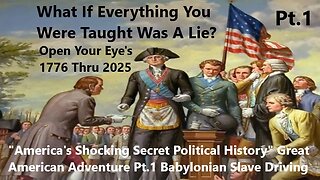 50:46
50:46
What If Everything You Were Taught Was A Lie?
15 days agoAmerica's True Shocking Secret Political History Great American Pt.1 Babylonian Slave Driving
2.61K8 -
 LIVE
LIVE
Tundra Tactical
1 hour ago $1.76 earnedLuis Valdes Of GOA Joins The Worlds Okayest Firearms Live Stream!!!
638 watching -
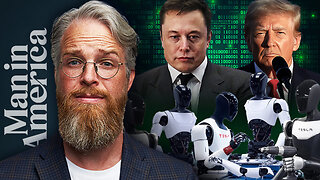 1:03:41
1:03:41
Man in America
10 hours agoAre Trump & Musk the COUNTER-ELITES? w/ Derrick Broze
20.4K3 -
 LIVE
LIVE
DLDAfterDark
1 hour agoDLD Live! SHTF Handguns! Which Would You Choose?
514 watching -
 1:50:38
1:50:38
Mally_Mouse
4 hours agoSaturday Shenanigans!! - Let's Play: Mario Party Jamboree
26.1K -
 1:13:00
1:13:00
Patriots With Grit
8 hours agoWill Americans Rise Up? | Jeff Calhoun
20.3K10 -
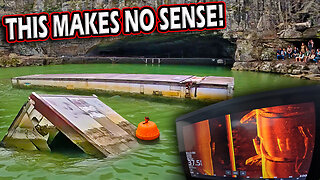 14:55
14:55
Exploring With Nug
8 hours ago $6.61 earnedWe Found Semi Truck Containers While Searching for Missing Man!
40.4K7 -
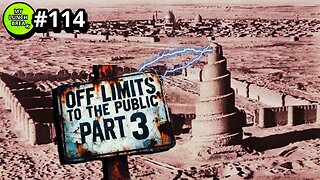 27:57
27:57
MYLUNCHBREAK CHANNEL PAGE
16 hours agoOff Limits to the Public - Pt 3
74.8K56 -
 38:07
38:07
Michael Franzese
8 hours agoLeaving Organized Crime and Uncovering Mob in Politics: Tudor Dixon and Michael Franzese
70.1K14 -
 2:42:54
2:42:54
Jewels Jones Live ®
2 days agoAMERICA IS BACK | A Political Rendezvous - Ep. 111
58.9K45